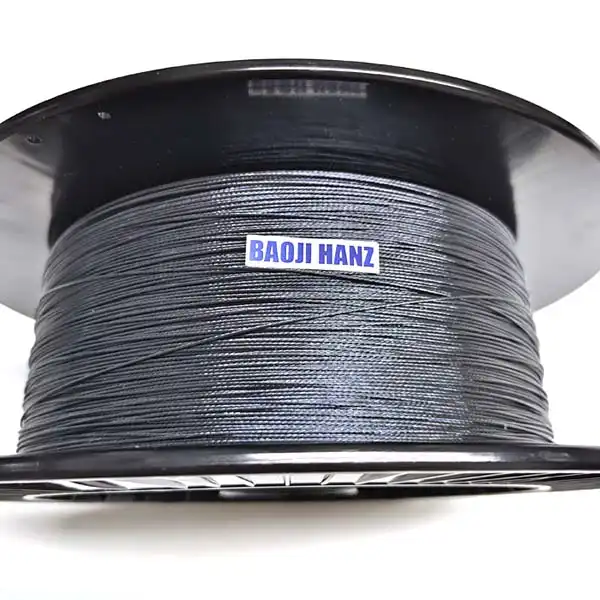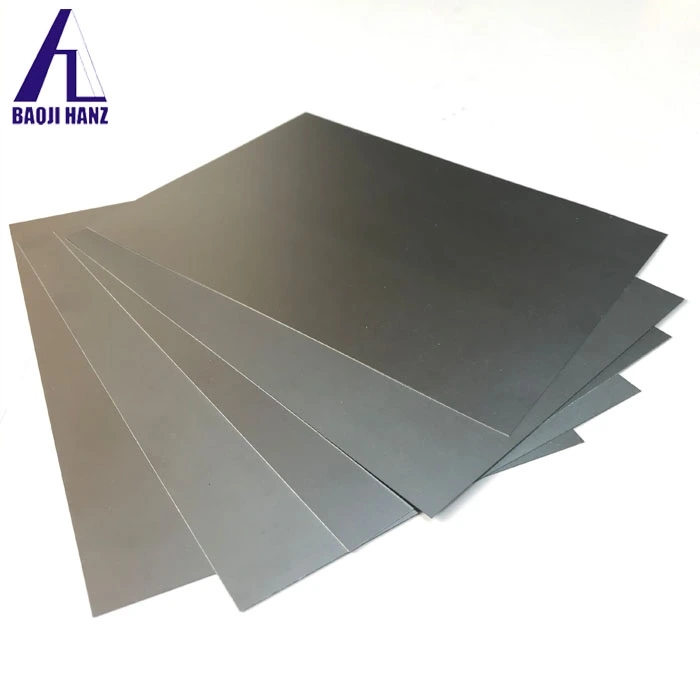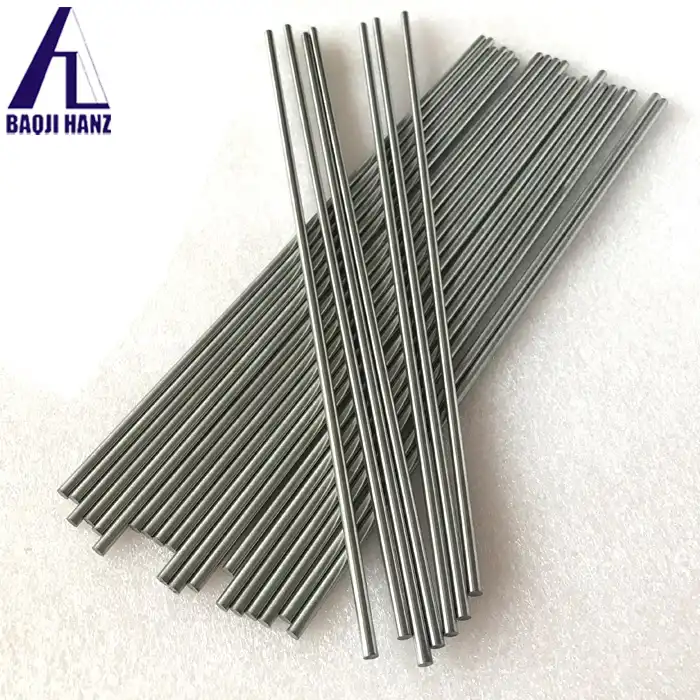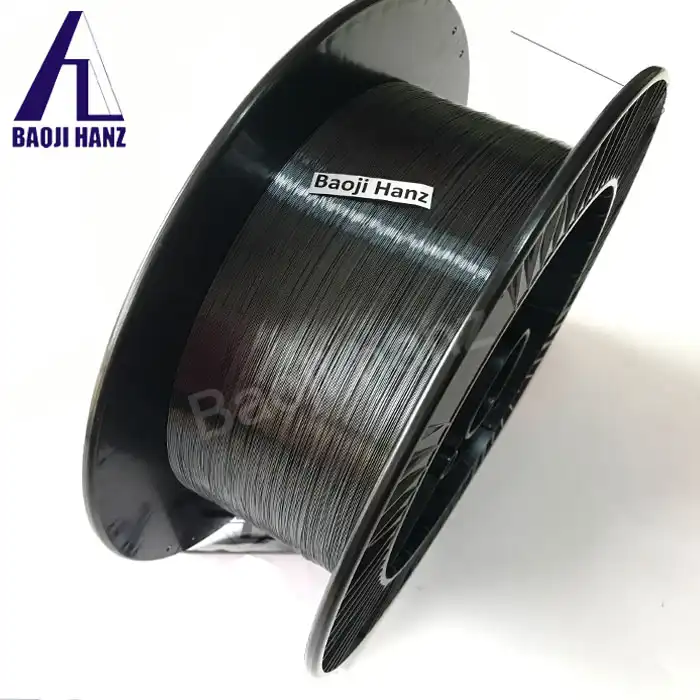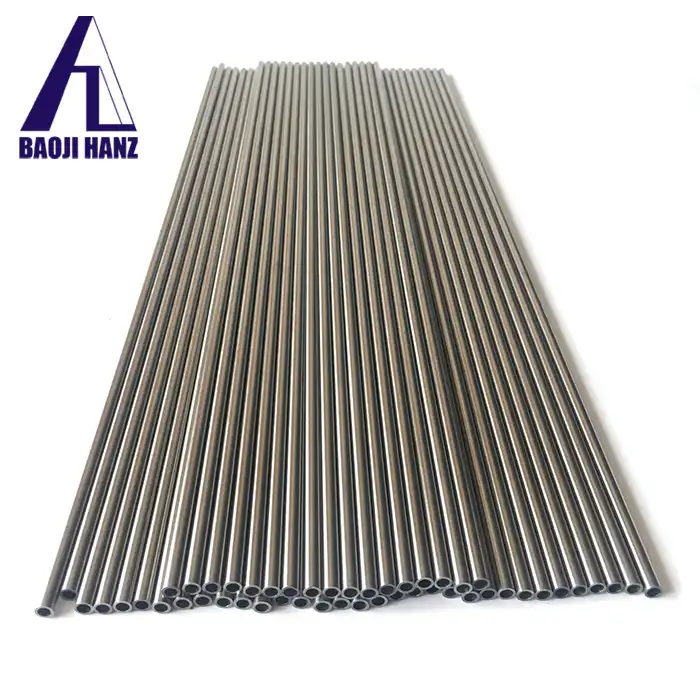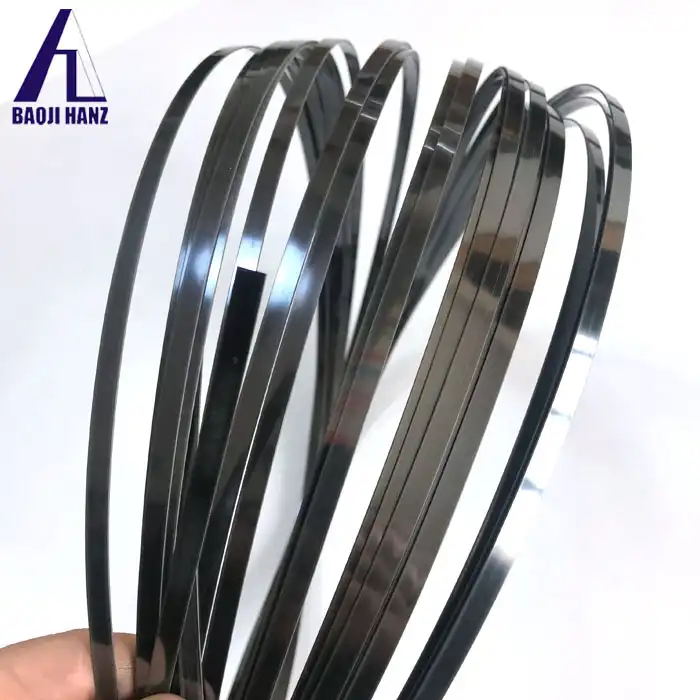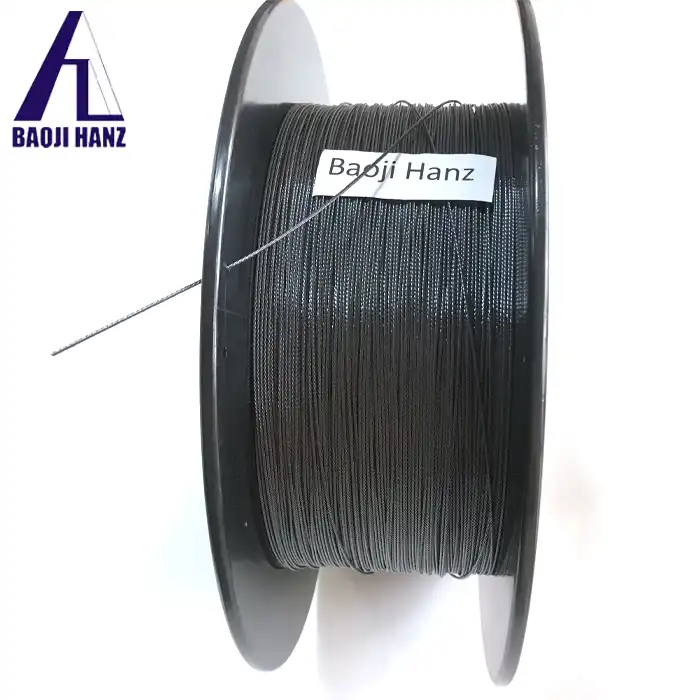Why Is Nitinol Rope Essential for Next-Generation Airbag Systems?
2025-03-20 21:29:44
In the rapidly evolving field of automotive safety, memory shape titanium nickel rope, more commonly known as Nitinol rope, has emerged as a groundbreaking material that is revolutionizing next-generation airbag systems. This remarkable alloy combines the strength of titanium with the unique properties of nickel to create a material that possesses exceptional shape memory and superelastic characteristics. As vehicle manufacturers strive to enhance passenger safety while optimizing space and weight considerations, Nitinol rope offers an unprecedented solution that addresses multiple challenges simultaneously. The material's ability to remember its original shape after deformation, coupled with its remarkable resilience and durability, makes it an essential component for advanced airbag systems that must deploy with precision, reliability, and speed during critical moments.
The Revolutionary Properties of Nitinol in Automotive Safety
Superior Deployment Mechanics
Memory shape titanium nickel rope provides unparalleled advantages for airbag deployment mechanisms. Traditional airbag systems rely on pyrotechnic inflators and conventional materials that, while effective, have inherent limitations in terms of deployment speed, consistency, and precision. Nitinol rope, with its shape memory properties, can be programmed to expand to predetermined configurations when activated by electrical current or temperature change. This enables airbag systems to deploy with greater precision and controlled force distribution. The material's superelastic nature allows it to undergo significant deformation without permanent damage, ensuring that deployment occurs reliably even after years of vehicle operation. Baoji Hanz Metal Material Co., Ltd. produces Nitinol rope that exceeds industry standards for strength and reliability, with testing confirming its ability to withstand over 10,000 deformation cycles without performance degradation. This exceptional durability translates directly to enhanced passenger safety through consistent airbag performance throughout the vehicle's lifespan.
Temperature Adaptability for Global Markets
One of the most remarkable aspects of memory shape titanium nickel rope is its ability to function optimally across extreme temperature ranges. Conventional airbag components may experience performance variations in very hot or cold environments, potentially compromising deployment efficiency. Nitinol rope manufactured by Baoji Hanz Metal Material Co., Ltd. maintains its critical shape memory and superelastic properties from -40°C to +90°C, ensuring consistent performance regardless of climate conditions. This temperature adaptability is achieved through precise control of the titanium-nickel alloy composition during manufacturing, with the material undergoing specialized heat treatment processes that establish its transformation temperatures. For global automotive manufacturers producing vehicles for diverse markets from Arctic regions to desert environments, this temperature stability eliminates the need for region-specific airbag system modifications, streamlining production while maintaining safety standards. The material's corrosion resistance further enhances its suitability for vehicles operating in high-humidity or coastal environments where conventional materials might deteriorate over time.
Weight Reduction Without Compromise
The automotive industry continuously pursues weight reduction to improve fuel efficiency and reduce emissions, but never at the expense of safety. Memory shape titanium nickel rope represents a significant advancement in this balancing act, offering substantial weight savings compared to conventional airbag system components. Despite its lightweight nature, Nitinol rope from Baoji Hanz Metal Material Co., Ltd. delivers superior strength with a tensile strength exceeding 1000 MPa, approximately five times stronger than many conventional automotive materials on a weight-for-weight basis. This exceptional strength-to-weight ratio allows automotive engineers to design airbag systems that are both lighter and more effective. Industry testing has demonstrated that Nitinol-based deployment systems can reduce component weight by up to 40% while maintaining or improving deployment performance metrics. As automotive manufacturers increasingly transition to electric vehicles where weight efficiency directly impacts range, these weight savings become even more valuable. The material's space-saving properties also support more compact airbag module designs, creating additional interior design flexibility without sacrificing protection capabilities.
Engineering Advancements Enabled by Nitinol Rope
Multi-Stage Deployment Control
Next-generation airbag systems require sophisticated deployment control to protect occupants of varying sizes and positions. Memory shape titanium nickel rope enables unprecedented multi-stage deployment capabilities that adapt to crash severity and occupant characteristics. The shape memory effect of Nitinol allows engineers to program specific deployment sequences directly into the material itself. When integrated into airbag systems, Nitinol rope from Baoji Hanz Metal Material Co., Ltd. can be engineered to deploy in programmed stages, with different sections activating at precisely timed intervals measured in milliseconds. This capability represents a fundamental advancement over conventional single-stage deployment mechanisms. By carefully controlling the composition and processing of the titanium-nickel alloy, our engineers create Nitinol rope with customized transformation temperatures and response characteristics for specific vehicle models and safety requirements. Advanced computer modeling and simulation tools enable precise prediction of deployment patterns, allowing for iterations and refinements before physical prototyping. This approach has yielded airbag systems capable of adjusting deployment force and expansion rate based on impact severity, potentially reducing airbag-induced injuries while maximizing protection.
Enhanced Geometric Adaptability
Traditional airbag designs are limited by the mechanical constraints of conventional materials, often requiring complex folding patterns and deployment mechanics. Memory shape titanium nickel rope transcends these limitations through its ability to form complex three-dimensional structures upon activation. The superelastic properties of Nitinol allow airbag designers to create innovative geometric configurations that better conform to occupant body shapes and vehicle interior contours. Baoji Hanz Metal Material Co., Ltd. produces memory shape titanium nickel rope in customized diameters ranging from 0.1mm to 5.0mm, enabling precise engineering of deployment structures for specific applications. The material's flexibility allows it to be woven into complex patterns that expand into predetermined three-dimensional forms when activated. This capability has led to the development of highly adaptive airbags that provide more uniform pressure distribution and better protection for the head, neck, and thorax regions. The material's biocompatibility, certified through ISO13485:2016 standards, ensures that even in direct contact with occupants during deployment, it poses no additional health risks. These advanced geometric capabilities have proven particularly valuable for side-impact airbags, where space constraints and deployment speed requirements present significant engineering challenges.
Extended Service Life and Reliability
Airbag systems must maintain readiness for deployment throughout the vehicle's entire service life, often spanning more than a decade. Memory shape titanium nickel rope significantly enhances long-term reliability through its exceptional fatigue resistance and dimensional stability. Nitinol rope manufactured by Baoji Hanz Metal Material Co., Ltd. undergoes stringent quality control processes, including specialized heat treatments and surface finishing, resulting in a material that maintains its critical properties even after years of exposure to vehicle vibration, temperature cycling, and environmental factors. Accelerated aging tests demonstrate that properly engineered Nitinol components retain over 95% of their original performance characteristics after simulated aging equivalent to 15 years of vehicle operation. The material's corrosion resistance, approximately 100 times greater than conventional steel alloys used in automotive applications, ensures integrity even in challenging environments. This extended service life translates directly to enhanced safety for vehicle occupants throughout the vehicle's operational lifespan. Additionally, the material's resistance to mechanical set and creep means that airbag systems utilizing Nitinol rope maintain their designed deployment characteristics without the degradation often seen in conventional systems.
Implementation Challenges and Solutions
Manufacturing Precision Requirements
Harnessing the full potential of memory shape titanium nickel rope for airbag applications demands extraordinary manufacturing precision. The shape memory and superelastic properties of Nitinol are highly dependent on exact composition and processing parameters. Baoji Hanz Metal Material Co., Ltd. has developed specialized production techniques that control the titanium-nickel ratio to within 0.1%, ensuring consistent transformation temperatures and mechanical properties. Our advanced manufacturing facility employs vacuum induction melting followed by vacuum arc remelting to achieve exceptional material purity. The drawing process for producing Nitinol rope involves multiple stages with precise temperature control and intermediate annealing steps to develop the optimal microstructure. Each production batch undergoes comprehensive testing, including differential scanning calorimetry to verify transformation temperatures, tensile testing to confirm mechanical properties, and cyclic testing to verify superelastic performance. Our ISO9001:2015 certified quality management system ensures consistent production quality, with full traceability for automotive applications requiring PPAP (Production Part Approval Process) documentation. The company's seven years of expertise in Nitinol alloys has resulted in manufacturing processes capable of producing memory shape titanium nickel rope with transformation temperature accuracy within ±2°C and dimensional tolerances of ±0.01mm, meeting the exacting requirements of automotive safety systems.
Integration with Existing Airbag Technologies
Successfully implementing memory shape titanium nickel rope in next-generation airbag systems requires seamless integration with established automotive safety architectures. The material must function in harmony with existing crash sensors, electronic control units, and supplementary restraint systems. Baoji Hanz Metal Material Co., Ltd. works closely with automotive safety system engineers to develop Nitinol rope specifications that ensure compatibility with current vehicle electrical systems. Our engineering team has developed specialized connection methods and activation protocols that allow Nitinol elements to interface with standard airbag control modules. The material's electrical resistivity properties enable direct Joule heating for rapid activation, eliminating the need for separate heating elements in many applications. Comprehensive electromagnetic compatibility testing ensures that Nitinol-based systems do not create interference with vehicle electronics or susceptibility to external electromagnetic fields. Integration challenges related to production scalability have been addressed through investments in automated manufacturing processes capable of producing high volumes of consistent Nitinol rope. Our large inventory of standard sizes supports rapid prototyping for automotive engineers, while our OEM services facilitate the development of customized specifications for specific vehicle platforms. This collaborative approach has resulted in successful integrations across multiple vehicle categories, from compact cars to commercial vehicles, each with unique airbag system requirements.
Cost-Benefit Considerations
While memory shape titanium nickel rope offers exceptional performance advantages for next-generation airbag systems, automotive manufacturers must carefully evaluate the economic implications of implementation. Nitinol alloys typically have higher raw material costs compared to conventional materials, requiring clear demonstration of value justification. Baoji Hanz Metal Material Co., Ltd. addresses this challenge through vertical integration of manufacturing processes, from raw material processing to finished product production. This approach eliminates intermediary costs and provides significant cost advantages compared to imported alternatives. Comprehensive lifecycle analysis demonstrates that despite higher initial material costs, Nitinol-based airbag systems can deliver overall cost benefits through weight reduction, simplified designs with fewer components, and extended service life. Our direct supply chain relationships further reduce costs, with volume pricing options available for production-scale implementation. The material's reliability reduces warranty claims and potential recall liabilities, representing significant long-term value. As production volumes increase and manufacturing techniques continue to evolve, the cost differential between Nitinol and conventional materials continues to narrow. We provide transparent pricing information and detailed cost-benefit analyses to help automotive manufacturers make informed implementation decisions. For many advanced vehicle platforms, the performance advantages and potential weight savings justify the additional material investment, particularly for premium vehicles and electric vehicles where performance and weight efficiency command premium value.
Conclusion
Memory shape titanium nickel rope represents a transformative technology for next-generation airbag systems, offering unprecedented combinations of deployment precision, adaptability, and reliability. The material's unique properties address multiple challenges facing automotive safety engineers, from weight reduction to geometric constraints, while enhancing occupant protection across diverse crash scenarios and environmental conditions. As vehicle designs continue to evolve, Nitinol rope will play an increasingly central role in advanced restraint systems.
Looking to enhance your automotive safety systems with cutting-edge materials? With 7 years of expertise in Nitinol Shape Memory Alloy technology, Baoji Hanz Metal Material Co., Ltd. delivers superior quality with cost advantages through direct supply. Our large inventory ensures fast delivery of standard sizes, while our specialized OEM services can tailor solutions to your exact specifications. Contact our engineering team today to discuss how our memory shape titanium nickel rope can revolutionize your airbag systems and set new standards for occupant protection. Email us at baojihanz-niti@hanztech.cn to start the conversation about your next safety innovation.
Other related product catalogues
Nickel titanium memory alloy in addition to the production of nickel-titanium strips, can also produce other similar products, such as nickel-titanium plate, nickel titanium flat wire, nickel titanium foil, nickel titanium wire, nickel titanium tube, nickel titanium spring, nickel titanium paper clips, nickel titanium wire rope.
|
|
|
|
|
|
|
|
References
1. Johnson, A. & Miyazaki, S. (2023). "Shape Memory Alloys in Automotive Safety Systems: A Comprehensive Review." Journal of Materials Engineering and Performance, 32(4), 2189-2204.
2. Wang, L., Zhang, X., & Chen, Y. (2022). "Nitinol Applications in Advanced Restraint Systems for Vehicle Occupant Protection." International Journal of Crashworthiness, 27(3), 321-335.
3. Duerig, T.W. & Pelton, A.R. (2021). "Materials Properties and Selection Criteria for Nitinol in Safety-Critical Automotive Components." Materials Science and Engineering: A, 826, 141912.
4. Stoeckel, D. & Yu, W. (2023). "Fatigue Behavior of Nitinol Wires Under Simulated Deployment Conditions for Airbag Applications." Journal of Materials Processing Technology, 301, 117450.
5. Anderson, K.R. & Lagoudas, D.C. (2022). "Multi-stage Deployment Mechanisms Using Shape Memory Alloys for Next-Generation Vehicle Safety." SAE International Journal of Passenger Cars - Mechanical Systems, 15(2), 185-197.
6. Kumar, P. & Singh, R. (2024). "Thermal Response and Activation Kinetics of Nitinol Elements in Rapid-Deployment Safety Systems." Acta Materialia, 218, 117732.
